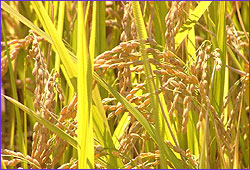 |
 |
|  Genetic engineering has allowed for healthier plants and bigger yields.
Genetic engineering has allowed for healthier plants and bigger yields.
|
Miracle of Rice
Part 2 | back to Part 1
Rice crisis
Rice is the staple in many Asian countries besides Japan, and in the early 1960s it became apparent that the fast-growing Asian population would soon begin devouring rice at a far greater pace than it could produce it, leading to widespread famine.
The newly formed IRRI's solution to this potentially crippling pan-Asian problem was dramatic and far-reaching. It transformed the rice plant, eking out new varieties with built-in solutions to three main obstacles. First, the institute's researchers genetically reduced plant height from about five feet to roughly three feet. This change allowed farmers to douse rice plants with larger amounts of powdered fertilizer without causing their stalks to sag and even topple from the weight of increased panicles (clusters of grain). Second, they shortened the plant's growing period from about 160 days to 110, so that in warm climates, irrigation could supplement seasonal rainfall, and farmers could raise two or three crops every year instead of just one. Lastly, rice varieties were bred to be resistant to the most crippling diseases and insect pests. In most areas where these new varieties were sown, the results were—and continue to be—staggering. According to IRRI, from 1967 to 1992 during the so-called Green Revolution, the world's rice harvest doubled. In some countries such as Indonesia, the national rice harvest more than tripled.
 In Japan, rice festivals ring in the new growing season and sow hope for a bountiful harvest.
In Japan, rice festivals ring in the new growing season and sow hope for a bountiful harvest.
|
|
But it's not over yet. Scientists have to reinvent the rice plant again in order to keep up with the still rapidly growing Asian population. The IRRI estimates that rice production must increase approximately 60 percent before the year 2020. One possible fine-tuning involves the addition of stalks to each plant (from about 15 to 25), allowing for more panicles per plant. The IRRI's Genetic Resources Center has a cold-storage unit that houses some 80,000 rice samples waiting to be crossbred into new varieties. The newest techniques in biotechnology and genetic engineering, which enable IRRI scientists to transfer the genes from one rice plant directly into the cells of another, reduce breeding time and allow for the transfer of specific traits. Instead of crossbreeding plants by hand in the field, scientists are now able to make finite genetic changes to plant embryos in test tubes, virtually ensuring the success of the transfer.
A miracle's miracle
Not surprisingly, the genetic manipulation of rice has become part of the increasingly polarized public debate about whether to welcome or ward off the addition of genetically modified foods into our diets. GM foods—so-called "Frankenfoods" in the minds of many people—made their commercial debut in the 1990s. Ever since, they have become the target of environmentalists and consumer advocates, who fear that genetically tinkering with the food we eat may have harmful repercussions for our health and the environment.
Specialists working on the rice plant would argue that the case of genetically engineered rice is different than that of other kinds of GM foods, such as mush-resistant bananas, self-fertilizing corn, and lettuce made unappealing to caterpillars. IRRI scientists have come up with Golden Rice, which is fortified with vitamin A and may benefit not just the wallets of the farmers who grow it but also the health of the consumers who eat it. This new rice, engineered to make its own supply of vitamin A (which gives the rice a golden color), could conceivably prevent blindness and even death among the developing world's poorest, most vitamin-A-deficient people. If that happened, it would be a miracle's miracle.
Lexi Krock is editorial assistant of NOVA Online.
Further reading
Seductions of Rice, by Jeffrey Alford and Naomi Duguid. New York: Artisan, 2000
The Rice Book: The Definitive Book on the Magic of Rice, by Sri Owen. New York: St. Martins, 1993
"Grains of Hope," by J. Madeleine Nash. Time, July 31, 2000 , 39-49.
Animal Transformations |
Miracle of Rice
Secrets of Hibernation |
Build a Rice Paddy |
Resources
Transcript |
Site Map |
Japan's Secret Garden Home
Editor's Picks |
Previous Sites |
Join Us/E-mail |
TV/Web Schedule
About NOVA |
Teachers |
Site Map |
Shop |
Jobs |
Search |
To print
PBS Online |
NOVA Online |
WGBH
© | Updated December 2000
|
|
|